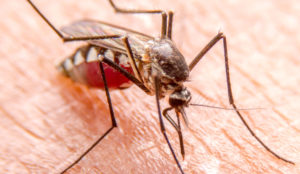
Malaria, a debilitating and sometimes fatal mosquito-borne illness, has been the object of many prevention efforts. Most of them focus on the vectors, various species of the Anopheles mosquito. To this end, the anti-malaria house offers a simple, effective way to reduce the occupant’s exposure to infected mosquitos.
What is malaria?
Common symptoms of malaria include fever, chills, aches, sweating, and vomiting. Travelers from areas where malaria is not endemic may mistake it for influenza. Accurate diagnosis requires a blood test for the parasites. With prompt, correct treatment, malaria is curable.
Four malaria parasites in the genus Plasmodium are responsible for the disease in humans. When the Anopheles mosquito bites an infected person, the parasites multiply in its stomach. When the mosquito bites someone else, the parasites enter that person’s bloodstream.
In humans, the parasites grow and multiply first in the liver cells and then in the red cells of the blood. In the blood, successive broods of parasites grow inside the red cells and destroy them, releasing daughter parasites (“merozoites”) that continue the cycle by invading other red cells. The blood stage parasites are those that cause the symptoms of malaria.—Centers for Disease Control and Prevention
After an incubation period ranging from 7 to 30 days, the symptoms appear. Some malaria parasites can remain dormant in the liver for months or years before reactivating and entering the blood. In this way, an asymptomatic person can introduce malaria where it was not endemic.
Natural immunity
Some people, mainly in West Africa, have natural immunity to malaria. Carriers for sickle cell anemia—that is, people with one sickle cell gene and one normal hemoglobin gene—are resistant to malaria. Also, where malaria is endemic, people develop some immunity to the disease due to repeated exposure.
Quinine and other preventives
The gin and tonic has saved more Englishmen’s lives, and minds, than all the doctors in the Empire.—Winston Churchill
If you’ve ever traveled to an area where malaria is endemic, you’ve most likely had to take anti-malarial medication. This used to be natural or synthetic quinine (chloroquine). Indeed, gin and tonic originated in the need for British colonials’ daily dose of quinine to prevent malaria. The sugar and soda—not to mention the gin—made the bitter quinine more palatable.
Video: How to make a gin and tonic worthy of Rudyard Kipling, “the prophet of British imperialism”.
However, as the parasites evolved resistance, other medications have been developed. A travel medicine clinic can provide an appropriate medication depending on which parasites are prevalent where you’re going and your particular health concerns.
Reducing exposure
Methods for reducing exposure to malaria focus on the vector, the Anopheles mosquito. On an individual scale, these methods involve vigilance and painstaking attention to detail. For example, because mosquitos need standing water in which to breed, you need to eliminate standing water in and near your house. That includes everything from puddles in your yard to water in your dog’s bowl.
Bed nets, particularly those treated with insecticide, can be highly effective in keeping mosquitos away while you sleep. But you have to be meticulous about not leaving any gaps and tucking the bottom of the net under your mattress. And that’s the case not only when you go to bed, but also if you get up during the night.
Where malaria exacts the largest burden, Africa, it has been extremely difficult to control. Many reasons account for this: an efficient mosquito that transmits the infection, a high prevalence of the most deadly species of the parasite, favorable climate, weak infrastructure to address the disease, and high intervention costs that are difficult to bear in poor countries.—Centers for Disease Control and Prevention
Communal anti-mosquito efforts tend to be environmentally unfriendly as well as expensive. Spraying insecticides and pouring kerosene on standing water leave toxins in the environment. Draining swamps destroys the habitat of more than just mosquitos, and it can have other detrimental effects such as removing erosion protection.
And whether efforts to reduce exposure are individual or corporate, they have to be consistent. That is, it’s not good enough to keep them up most of the time.
The anti-malaria house
In Africa, the principal vector for malaria is the Anopheles gambiae mosquito. Because most malaria-bearing mosquitos fly within 1 m of the ground, researchers in Gambia investigated house elevation as a way of reducing the numbers of mosquitos inside.
They built four huts with hoists so they could vary the elevation of the floor from 0 to 3 m above the ground. Each night, two men slept under bed nets in each hut. Light traps caught the mosquitos so that researchers could count how many came into each hut.
Compared with huts resting directly on the ground, huts 3 m above the ground had 84% fewer Anopheles gambiae mosquitos. That is, simply elevating a house 3 m above the ground goes a long way toward making an anti-malaria house. Best of all, once you’ve built an anti-malaria house, you don’t have to do anything to keep it that way. And elevating the house doesn’t adversely affect the environment as many other anti-malaria measures do.
Naturally, you should use additional preventive measures such as bed nets and Malarone for further protection. And while we don’t recommend day drinking, you might want to have a gin and tonic just in case.
